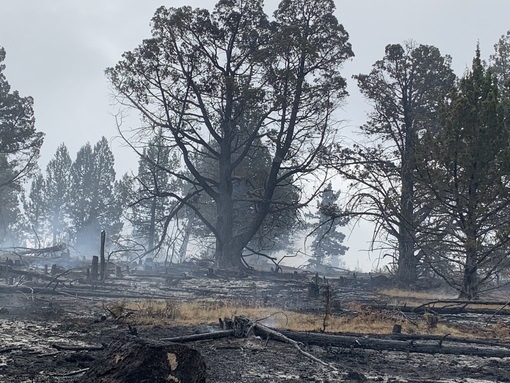
For many years, BLM had plotted a massive deforestation project aimed at destroying ancient juniper trees living on Juniper Mountain in the Owyhee Canyonlands. The mountain is a long high ridge cut by headwater drainages of the Middle and North Fork Owyhee Rivers and Red Canyon Creek. Its right by the Oregon border, and has splendid views of the sagebrush country below, with vistas extending to Steens Mountain in the west and the Owyhee Plateau to the east.
As summer ended, news of an imminent 13,000 acre prescribed burn in the Trout Springs area of Juniper Mountain seeped out. I drove out to the site and was horrified by what I saw. Since I was last there in spring 2018, BLM contractor crews had sawed down younger trees across thousands of acres of the mountain, even clambering over cliff breaks and on top of rock outcrops. The cut trees were tinder dry with resinous needles red-brown and covered the ground surface all around old trees. It would be impossible for BLM to burn and not kill many thousands of ancient junipers. It was clear that was precisely BLM’s intention. Scattered patch burns, claimed to be blacklining, had already been ignited last spring in a trial run killing old growth. I returned to Boise, deluged the BLM Manager with e-mails and photos and told her the Fuels staff were clearly planning to kill vast numbers of ancient trees. She said she was surprised that older trees would burn.


Inside one of BLM’s ancient tree kills from the spring.

Old trees awaiting their fate, surrounded by expanses of dry cut trees. Juniper forests normally have very little downed wood. When set on fire, the dry trees and needle resins produce extreme heat killing or igniting surrounding live trees, scalding soils and shattering rock chunks off boulders and cliff faces.
I returned to Juniper Mountain days later, accompanied by Dave Hayes, a retired forester, to reconnoiter further. BLM had already started burning. Fire crews were amassed on a meadow. A brief rain squall had downed the contractor helicopter used for napalming the forest by shooting out flammable gel-drenched ping pong balls as it flies over.
We drove on, past trees blackened, smoldering and dying. We were soon blocked by a BLM truck and forbidden to pass by Lance Okeson, BLM’s fuels person in charge of the burn. A BLM law enforcement officer was summoned on the radio. While waiting for the law to show up, Okeson said “You can do what you want but you’re not going to get very far Katie”. I thought to myself: What kind of monster gloats over his power to destroy beautiful ancient trees?
The BLM lawman finally arrived, decked out in near-combat gear. We were loudly asked half a dozen times if we knew the Owyhee County sheriff had closed the area to public entry. We said No, and that there weren’t closure signs posted. Okeson mumbled “we’re working on that”. We were ordered to leave immediately and not come back until the closure was lifted, or we would be issued citations. We were followed off the mountain.
This beautiful montane western juniper forest had long been targeted by cattlemen and their BLM range enablers and cronies. Ranchers covet the grass protected by branches at the base of junipers, have always hated the trees, and pressured BLM to eradicate them. Smaller agency burns, tree cutting, a chaining, along with the cowboy lightning of past rancher burning attempts and some wildfires nursed along by BLM had removed trees over the years. There had been CCC era cutting – with telltale old stumps and rusty cans scattered across the mountain. A wave of forest attacks took place during the heyday of government-funded juniper and sagebrush community destruction of the 1960s-1970s. But nothing at the scale BLM proposed in 2012 when it released NEPA EA documents for the Trout Springs and Pole Creek grazing allotments. The EAs included “rangeland health” assessments that blamed the native western junipers as a primary cause of lands flunking the health standards. Besides dealing directly with grazing, the EAs included a plethora of juniper “treatments” – cutting, girdling, jackpot burning (burning concentrations of cut down dry trees – evidently this is quite a rush, hence the name), pile burning and general conflagration. The sure cure for the ailing range was radical deforestation across this landscape.
Juniper forests are naturally the most fireproof areas here. Forested sites retain moisture longer, shade and cool the ground surface, and block the wind. Grass is more likely to burn than sage, and sage more likely to burn than junipers. This is especially the case in the rugged mountainous terrain with myriad rock outcroppings and intricately cut canyons, where rock and cliff outcroppings serve as natural firebreaks. The rugged terrain had allowed magnificent stands of juniper and old trees to develop, branches adorned with chartreuse lichens. The trees are impossible to age, as they invariably rot in the center. Western juniper can live to be 1600 years old. Trees here were undoubtedly 300, 400, 500 years old, and some were pre-Columbian. Each old tree was shaped by time, the elements, its neighbors, and was distinctive in its own right.
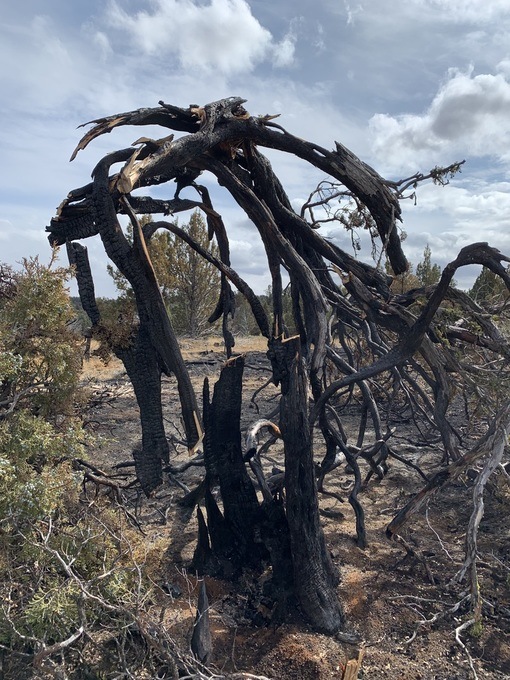


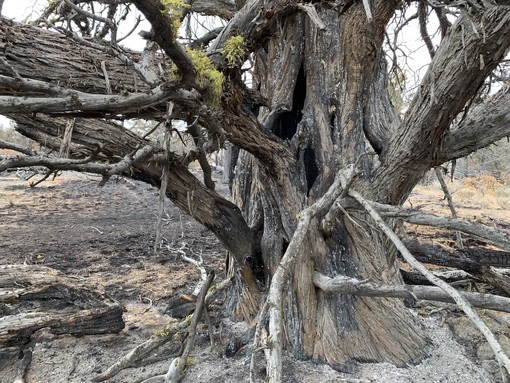
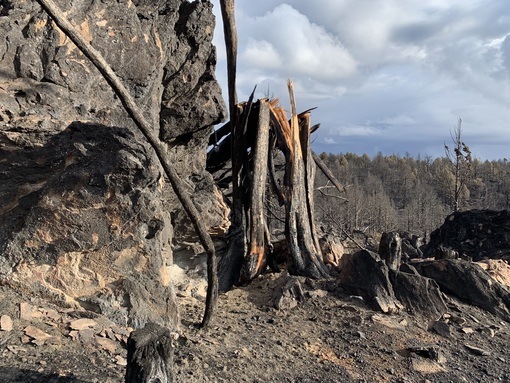
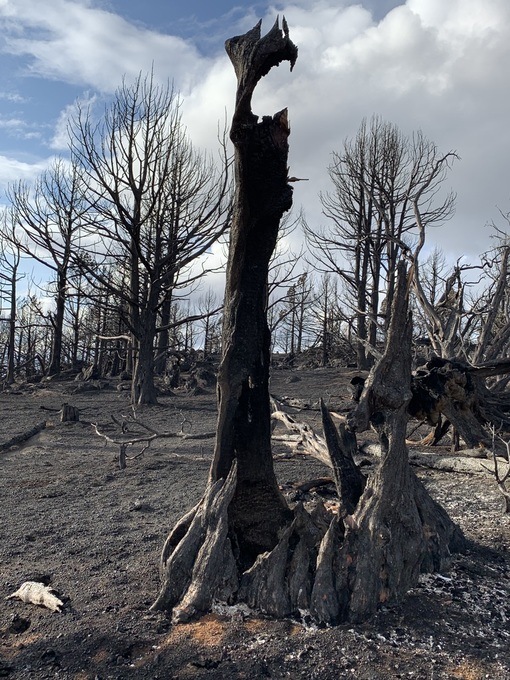





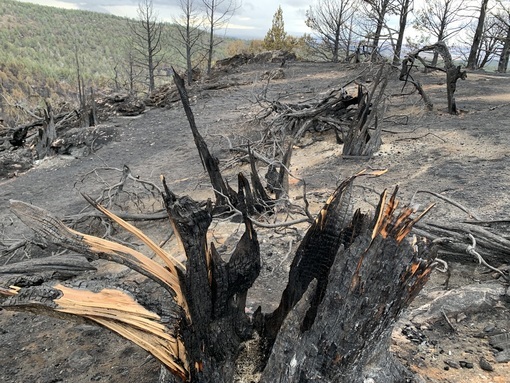

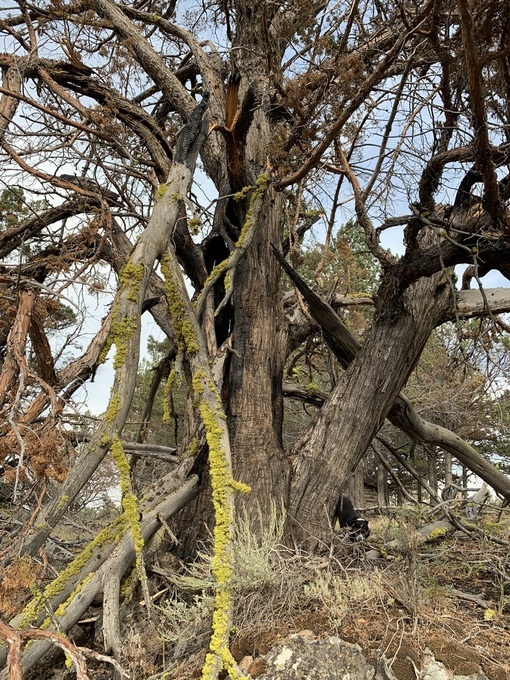


The old trees have a singular presence that still reaches out and touches us after their death. Their skeletons stand as testimony to BLM’s lies and ecocide.
The cores of ancient trees are rotten, dry and full of air, pockets with only the dense outer live wood containing moisture. Once ignited – poof – only the outer shell remains. The heat of the fire generated by burning the carpet of tinder dry cut trees also killed many old trees that did not directly ignite, with all needles on a tree immediately turning brown, and some whole tree foliage a ghostly gray. BLM ground crews hunted down and burned up individual old trees when there were no cut dried trees to carry a fire.

The shell of an ancient tree – live wood around the perimeter is the only thing that didn’t vaporize. This tree was by an access road, apparently sawed off in a post mortem.
Alternate Reality Feeds the BLM Treatment Machine
A web of federal agencies and profiteering NGOs have spent many years developing a bizarre alternate range reality fed by endless federal grants and stacks of circular reasoning range papers. BLM used to claim that the only place juniper trees were supposed to grow was rocky outcrops and shallow soil areas. That was before the huge windfall of Fuels and Sage-Grouse funding in the past 15 years. Now hundreds of millions of dollars are spent annually in a mind-boggling deforestation campaign raging across the West. Trees are an enemy anywhere they exist.
Based on this alternate reality, BLM’s grazing land health assessments fault the trees for nearly very land problem under the sun. The goal is to maximize cattle forage grass production by using the trees as a scapegoat. The assessments have gotten ever more warped since their inception in Bruce Babbitt’s Range Reform of the Clinton era.
BLM, cattle industry consultants, USDA NRCS (funnels funds to ranchers for cow projects- fences, water, tree killing), the Nature Conservancy (gets lucrative government contracts to generate fire intervals and other claptrap justifying major human intervention in wild lands ecosystems across the West and also provides feel-good cover for the livestock industry), Land Grant college range departments, and more recently the USGS – all have been involved in concocting this alternate reality. They churn out fire, ecosite, state/transition and other models of idealized and “desired” plant communities to justify massive deforestation. It doesn’t matter what the overwhelming visual and ecological evidence on the land shows. The models, and BLM’s NEPA documents, ignore that.
The models are blind to the historical record. The earliest Juniper Mountain General Land Office survey was conducted in 1914 (later than surveys because of little settlement value in the remote rugged area). I and colleagues had reviewed and submitted these records to BLM when appealing the EAs. The surveyors had found old juniper trees across Juniper Mountain. Surveyors arduously laid out what would become section lines using long lengths of chain, recorded compass bearings at specific intervals and used bearing trees in the descriptions. They scribed (carved) marks on the trees and recorded the diameter at breast height. They often noted the general vegetation that settlement in the area might exploit. BLM’s bogus models are in denial of the historical plant community record, as shown in Interior’s own surveyor records.
Lawlessness
Juniper Mountain has long been known as a lawless region. An 1860s era silver mine boom in the Owyhee mountains to the north didn’t touch this lair of horse thieves. Recent ranching operations have been notorious for lawlessness, including when the Trout Springs grazing EA process was taking place. Mike Hanley, a Trout Springs permittee, had been such an egregious cattle trespasser that BLM actually canceled his grazing permit – a prolonged process of legal wrangling under the agency’s grazing regulations and institutional and political pressures that circle the wagons around welfare ranchers at all costs. Another local rancher owned a cow sale yard in Nevada. He trucked in hundreds of old cows and dumped them out all over the mountain at a time when allotments were temporarily closed as a result of litigation over BLM foot-dragging on long-promised grazing evaluations. A decade before that, Owyhee ranchers had poached 4 of the largest bull elk killed in Idaho at night right by the Trout Springs exclosure on Juniper Mountain.
Now the current Idaho BLM Director is John Ruhs. I had encountered Ruhs encouraging and aiding abusive public lands ranchers in Nevada in the Argenta and North Buffalo allotments during the Obama administration. He also ignored blatant rancher violations of the Wild Horse and Burro Act in Fish Creek allotment where he attempted to humiliate the Battle Mountain District Manager who had dared stand up to a rancher scofflaw. That incident is described in Chris Ketcham’s This Land. The Trout Springs EA that justified the Owyhee juniper killing claimed shallow soil areas and older trees stands would be avoided. Instead, these were often primary sites where BLM’s aerial napalming and ground drip torches focused. With Ruhs at the helm, the fuels and range staffs have free rein to destroy whatever is their pleasure in service to the livestock industry, ignoring any NEPA document commitments made to the public.
Silent Winter

The ongoing West-wide destruction of juniper forests represents a tremendous loss of biodiversity, especially migratory bird diversity. The forests come alive with birds in the winter when Townsend’s solitaires, American robins and at times cedar waxwings subsist on juniper berries. Solitaires establish intraspecific territories where they sing and spar with other solitaires in defense of berry-laden trees. Flocks of robins wheel through the air, descending on trees. Cooper’s hawks flit through the forest, and lurk for prey. Solitaires have been documented returning to the same place in winter. Such sadness to think of a bird returning to a winter home site and finding its habitat senselessly obliterated.
I returned to Juniper Mountain last week to view the burn aftermath. A cold snap brought thunderstorms and then snow overnight. Some solitaires had returned for the winter. They were calling and singing bits of broken song. Burned areas were silent and lifeless, except for flickers digging a fleeting bonanza of ant larvae roasted by the fire out of collapsed mounds amid scalded soils.
FOIA documents show that BLM knew full well that it would destroy habitat for a broad diversity of nesting birds in the mature and old growth Owyhee juniper forest. The forest had been nesting habitat for hermit thrushes (renowned for their melodic song) whose presence here was a testimony to the structural complexity and stability of the forest, and to goshawks, mountain bluebirds, black-throated gray warblers, kestrels, mountain chickadees, ash-throated flycatchers and many others. There is greater nesting bird diversity in juniper communities than in sagebrush.
No one should believe that BLM cares about sagebrush species, either, including sage-grouse which are so often used as an excuse for spending huge sums on deforestation projects. The burn targeted the biggest and densest patches of sagebrush habitat where Brewer’s sparrow and Green-tailed towhee nested, along with the best stands of old mountain mahogany.
WSAs Released in Owyhee Initiative Legislation
Nearly all the lands on Juniper Mountain had been inside BLM Wilderness Study Areas until the passage of the Owyhee Initiative (OPLMA) wilderness bill, touted as a product of epic collaboration. In 2009, the bill released three Wilderness Study Areas – Middle Fork Owyhee River, Little Willow and West Fork Red Canyon Creek WSAs that comprised the wildest areas of the Canyonlands. The bill was a result of environmental groups letting themselves be led around by county supremacy and Agenda 21 zealot Fred Kelly Grant and the cattlemen. The ranchers dictated what lands were allowed to become wilderness.
Surprisingly, after the WSAs were released, some concerned BLM staff had gone back and conducted new “Lands with Wilderness Characteristics” inventories. They determined that indeed all the areas contained wilderness-worthy attributes. Screening cover provided by the juniper forests was an important factor in the determinations. If the cover were to be destroyed, those evaluations may be re-visited.
Shock Doctrine, Reset, Piles of Wood Chips 2-3 Feet Deep
Government funded juniper killing range scientists have recently used the term
shock in describing chaining, masticating, bull hogging and “prescribed fire” “treatments”, for example this posse of authors:
“Reduction of woody vegetation represented a “shock” to the system each time a treatment was applied to a plot. This shock can be envisioned as a wave with magnitude and duration that differed for each variable measured.” McIver et al. Sage-step Project.
The Sage-step project was developed to justify expensive manipulation “treatment” of woody plant communities, ostensibly to benefit sagebrush species, with study sites often selected to achieve fore-ordained research results.
A new twist in this revealing terminology is used by BLM’s Okeson in the video of the helicopter strafing the Trout Springs juniper forest with napalm. Okeson states: “We need a total reset”.
In an Idaho Rangeland Resources Commission (arm of Idaho ranching industry) article, Okeson describes why attacking the juniper forests of the Owyhees merely with masticator machines grinding up whole trees and spitting them out as piles of wood chips won’t work:
“We’re trying to get after it on a landscape scale,” says Lance Okeson, Boise BLM Fuels Specialist. “Mastication seems like a good technique when you are trying to open up smaller meadow areas, but on a landscape scale, it may not be practical.”
Trying to grind up all the juniper trees on Juniper Mountain, for example, would leave wood chips covering the ground “2-3 feet deep,” Okeson said.”
Yes indeed. A complex thriving native forest thriving without human intervention and combatting the climate crisis. BLM chose to release the carbon stored in the trees into the atmosphere, feeding climate change.
In the 1990s, I had worked on the habitat program of the Idaho Game Department. My boss had dealt years before with BLM range people involved in the many forms of destruction of sagebrush for cattle forage. He had seen how they lusted to burn up sagebrush. He called them pyromaniacs. Nothing has changed with today’s full-bore assault on junipers.
Cattle-driven ecocide in the Amazon. Cattle-driven ecocide in the Gran Chaco. Cattle driven ecocide in the American West. The end result is the same. Here the U.S. government is openly and lavishly funding radical deforestation, justifying it with reams of propaganda claiming to be making the land “healthy”, saving sage-grouse, or preventing fires. This all is fortified by crazy models and range myths that generate an alternate reality where the trees should not exist. Killing the ancient Owyhee junipers was also an attempt to try to extinguish the stark visual evidence that this scheme is based on bald-faced lies.
Katie Fite is a biologist and Public Lands Director of WildLands Defense in Boise, Idaho.